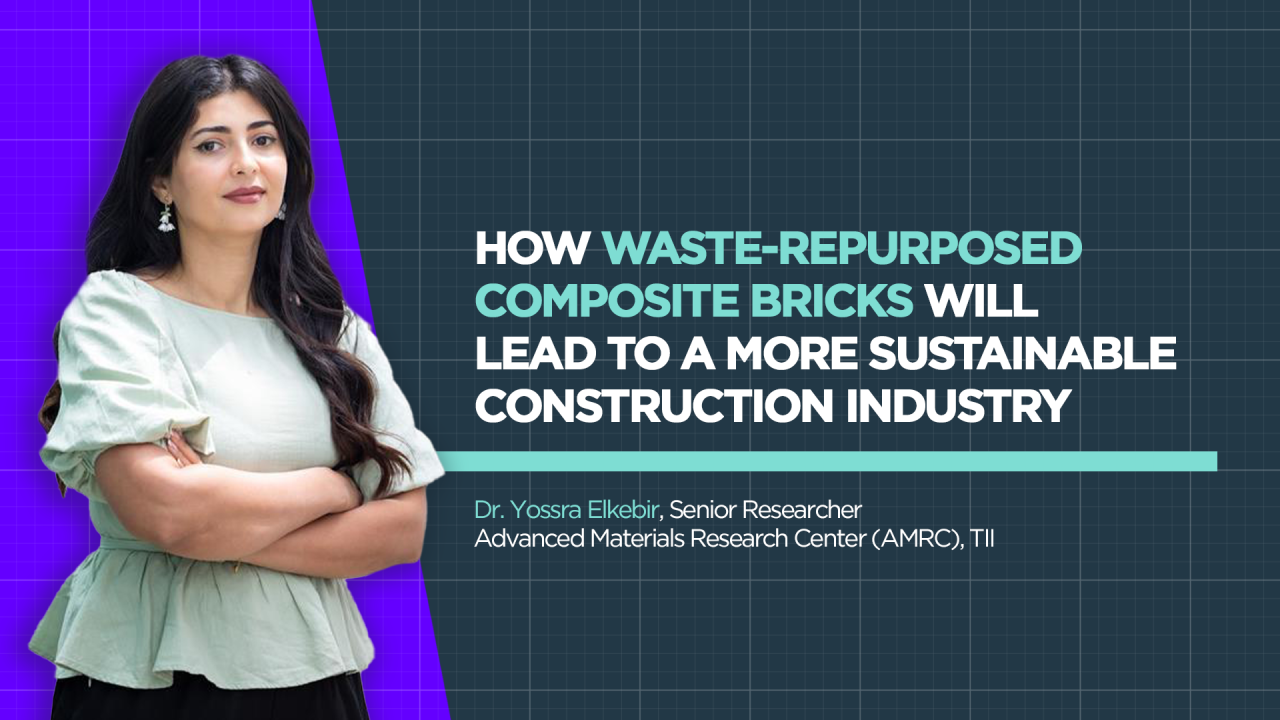Cement has long been an essential component of constructions in civil engineering, but its impact on the environment is undeniable.
The building and construction sector is the largest emitter of greenhouse gasses, accounting for 37% of global CO2 emissions, while the cement industry is responsible for 7% of global emissions, mainly due to the use of fossil fuels in the production of cement.
The use of low-carbon fuels or alternative fuels can minimize emissions but that’s only one aspect of the impact. The extensive use of water in cement production also weighs significantly on global water challenges. Faced with this urgent need for sustainable and less polluting building materials, the Technology Innovation Institute has focused its efforts on finding a solution and one of our research associate, Yossra Elkebir , has been able to produce a new alternative to traditional cement bricks that is innovative and sustainable.
An alternative to cement bricks
The new bricks based on waste-repurposed composite are made from bio-based materials, recycled materials, waste and natural fibers by combining natural additives with bio-based binder. They’re environmentally friendly and have a lower carbon footprint than bricks made from traditional cement.
Repurposing waste for structural and aesthetic applications in infrastructure and construction is a pioneering approach that promises a more sustainable construction industry. It also aligns with global efforts to lower carbon emissions and promote a more circular economy in construction practices.
In December, at COP28 in Dubai, Canada and the UAE launched the Cement and Concrete Breakthrough along with endorsing countries that include the UK, Ireland, Turkey and Germany. The initiative aims to make clean cement the preferred choice in the construction industry globally, with near-zero emission cement production established and growing in every region of the world by 2030.
By developing these innovative bricks, our goal at TII is to influence building standards and practices to incorporate more sustainable materials and reduce the impact on the environment. Cement production releases about 0.8 tonnes of CO2 per tonne produced. If these bricks can replace even 10% of cement usage globally, this could potentially save roughly 80 million tonnes of CO2 emissions annually.
We also believe that it’s crucial to commit to resource efficiency and conservation. By utilizing waste materials that would otherwise end up in landfills, the new bricks are also contributing to circularity. But finding an alternative to the traditional cement brick came ensues its own sets of challenges. The bricks using bio-based binders and natural additives must be compatible and must perform equivalently or better than traditional cement-based counterparts. They must provide the desired mechanical strength and durability, which requires extensive testing and formulation optimization.
Achieving certification from regulatory bodies also stands out as a critical challenge. New construction materials, such as waste-repurposed composite bricks, require comprehensive testing to secure approval from relevant authorities. This process typically demands a considerable amount of documentation and experimentation to prove that the materials adhere to all established safety and performance standards.
Demonstrating the long-term durability and structural integrity of innovative materials can be especially demanding and protracted.
The key role of technology
Advanced manufacturing methods and material science were central to the development of bio-based binders and composite materials to ensure they comply with cement manufacturing and testing standard such as EN 196-1, which focuses on cement testing. Techniques including mechanical testing, thermal cycling, water absorption, and durability assessments were also critical in refining the material formulations to meet the necessary standards. These technologies guaranteed that the bricks are not only sustainable but also structurally robust and durable across diverse environmental conditions. As part of our research, we also relied on collaborations with key actors. We worked closely with cement manufacturing facilities to conduct extensive testing and validation of the waste-repurposed composite bricks in real-life conditions. It allowed us to collect crucial data on performance in actual construction settings. We could then refine the material based on feedback and empirical evidence.
What’s next?
Our main goal with this breakthrough is for construction companies to begin using the sustainable bricks in their projects. Ultimately, we envision that the bricks will replace traditional materials. The waste-repurposed composite bricks can be used in many instances including in structural elements, wall construction, flooring as well as outdoor landscaping. In the immediate term, we are working diligently to obtain certification and ensure compliance with relevant construction and environmental standards.
Concretely, it means conducting further tests, continuing to gather extensive data and engaging with standard bodies. We must demonstrate that the waste-repurposed composite bricks meet all necessary safety, performance, and environmental criteria. The next step will be to scale up the production process by refining manufacturing techniques to increase the throughput while maintaining quality consistency, upgrading facilities and potentially automating certain processes. We must also let the construction companies know that these revolutionary bricks exist, explaining their benefits and creating partnerships and pilot projects to demonstrate their efficacy and benefits.
With waste-repurposed composite bricks, we can build a more environmentally-friendly world, one brick at a time.


